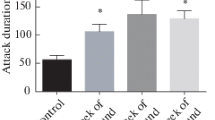Abstract
Intoxicated and nonintoxicated subjects were given the opportunity to administer a potentially injurious level of shock to an opponent who behaved in either a provocative or an extremely provocative manner. The provocative opponent attempted to administer high-intensity shocks to the subject. The extremely provocative opponent attempted to administer high-intensity shocks and the potentially injurious level of shock. The intoxicated subjects in the extreme provocation condition evidenced the greatest increase in the use of the potentially injurious shock. It was concluded that aggression is a function of the interaction of alcohol consumption and level of provocation.
Similar content being viewed by others
References
Carpenter, J. A., & Armenti, N. P. Some effects of ethanol on human sexual and aggressive behavior. In B. Kissin & H. Begleiter (Eds.),The biology of alcoholism: Physiology and behavior (Vol. 2). New York: Plenum Press, 1972.
Goodwin, D. W. Alcohol in suicide and homicide.Quarterly Journal of Studies on Alcohol 1973,34 143–156.
Kaplan, J.Marijuana: The new prohibition. New York: Thomas Y. Crowell, 1970.
Mulvihill, D. J., Turmin, M. M., & Curtis, L. A.Crimes of violence (a staff report to the National Commission on the Causes and Prevention of Violence). Washington, D.C.: U.S. Government Printing Office, 1969.
National Institute on Alcohol Abuse and Alcoholism.Alcohol & health (DHEW Publication No. (ADM) 74-68). Washington, D.C.: U.S. Government Printing Office, 1971.
National Institute on Alcohol Abuse and Alcoholism.Alcohol & alcoholism: Problems programs & progress (DHEW Publication No. (HSM) 72-9127). Washington, D.C.: U.S. Government Printing Office, 1972.
Shortell, J., Epstein, S., & Taylor, S. P. Instigation to aggression as a function of degree of defeat and the capacity for massive retaliation.Journal of Personality 1970,38 313–327.
Shuntich, R. J., & Taylor, S. P. The effects of alcohol on human physical aggression.Journal of Experimental Research in Personality 1972,6 34–38.
Shupe, L. M. Alcohol and crime: A study of the urine alcohol concentration found in 882 persons arrested during or immediately after the commission of a felony.Journal of Criminal Law and Criminology 1954,44 661–665.
Taylor, S. P. Aggressive behavior and physiological arousal as a function of provocation and the tendency to inhibit aggression.Journal of Personality 1967,35 297–310.
Taylor, S. P., & Gammon, C. B. Effects of type and dose of alcohol on human physical aggression.Journal of Personality and Social Psychology 1975,32 169–175.
Taylor, S. P., & Gammon, C. B. Aggressive behavior of intoxicated subjects: The effect of third-party intervention.Journal of Studies on Alcohol 1976,37 917–930.
Taylor, S. P., Gammon, C. B., & Capasso, D. R. Aggression as a function of alcohol and threat.Journal of Personality and Social Psychology 1976,34 938–941.
Taylor, S. P., Schmutte, G. T., & Leonard, K. E. Physical aggression as a function of alcohol and frustration.Bulletin of the Psychonomic Society 1977,9 217–218.
Taylor, S. P., Vardaris, R. M., Rawitch, A. B., Gammon, C. B., Cranston, J. W., & Lubetkin, A. I. The effects of alcohol and delta-9-tetrahydrocannabinol on human physical aggression.Aggressive Behavior 1976,2 153–161.
Wolfgang, M. E., & Strohm, R. B. The relationship between alcohol and criminal homicide.Quarterly Journal of Studies on Alcohol 1956,17 411–425.
Author information
Authors and Affiliations
Additional information
This research was supported in part by the National Institute on Alcohol Abuse and Alcoholism, Grant AA02125.
Rights and permissions
About this article
Cite this article
Taylor, S.P., Schmutte, G.T., Leonard, K.E. et al. The effects of alcohol and extreme provocation on the use of a highly noxious electric shock. Motiv Emot 3, 73–81 (1979). https://doi.org/10.1007/BF00994162
Issue Date:
DOI: https://doi.org/10.1007/BF00994162




